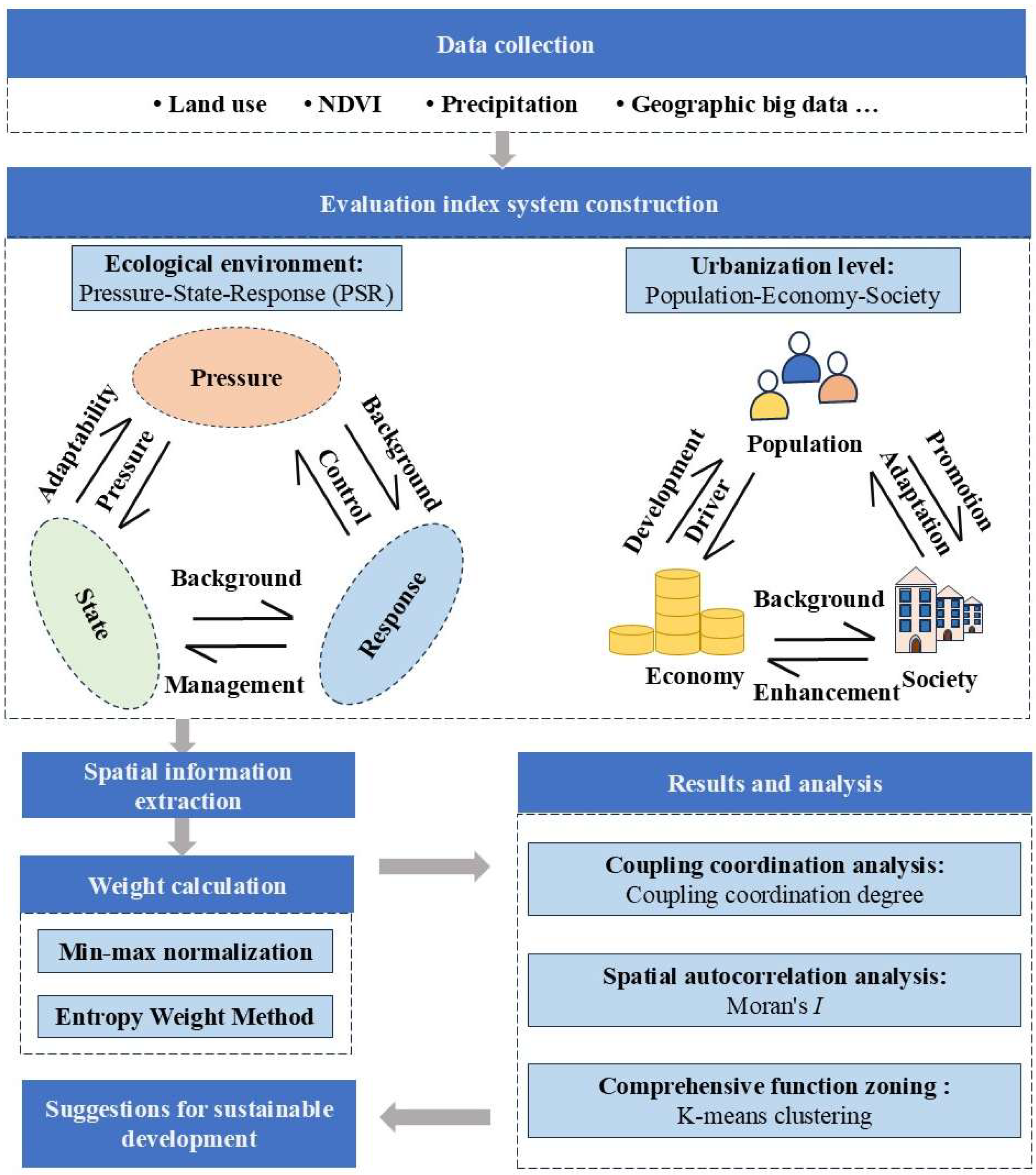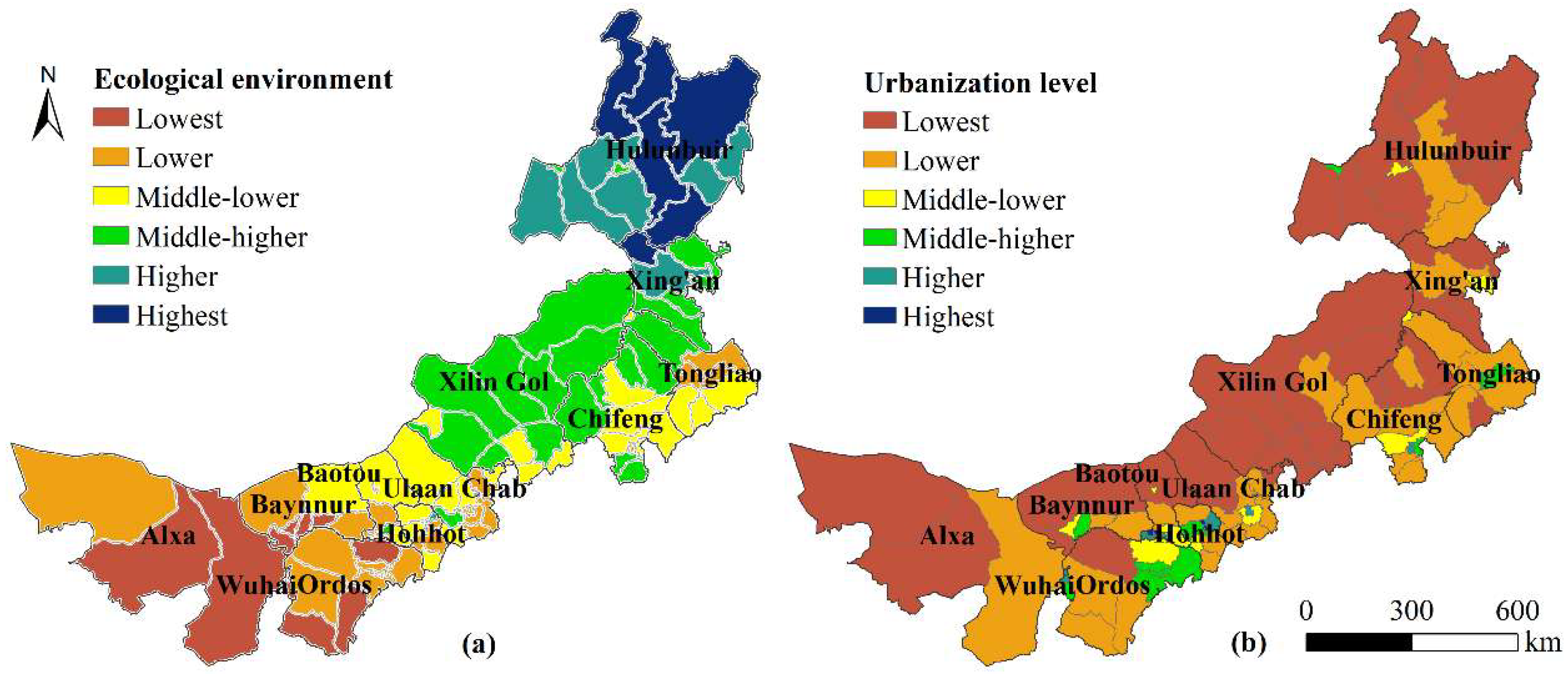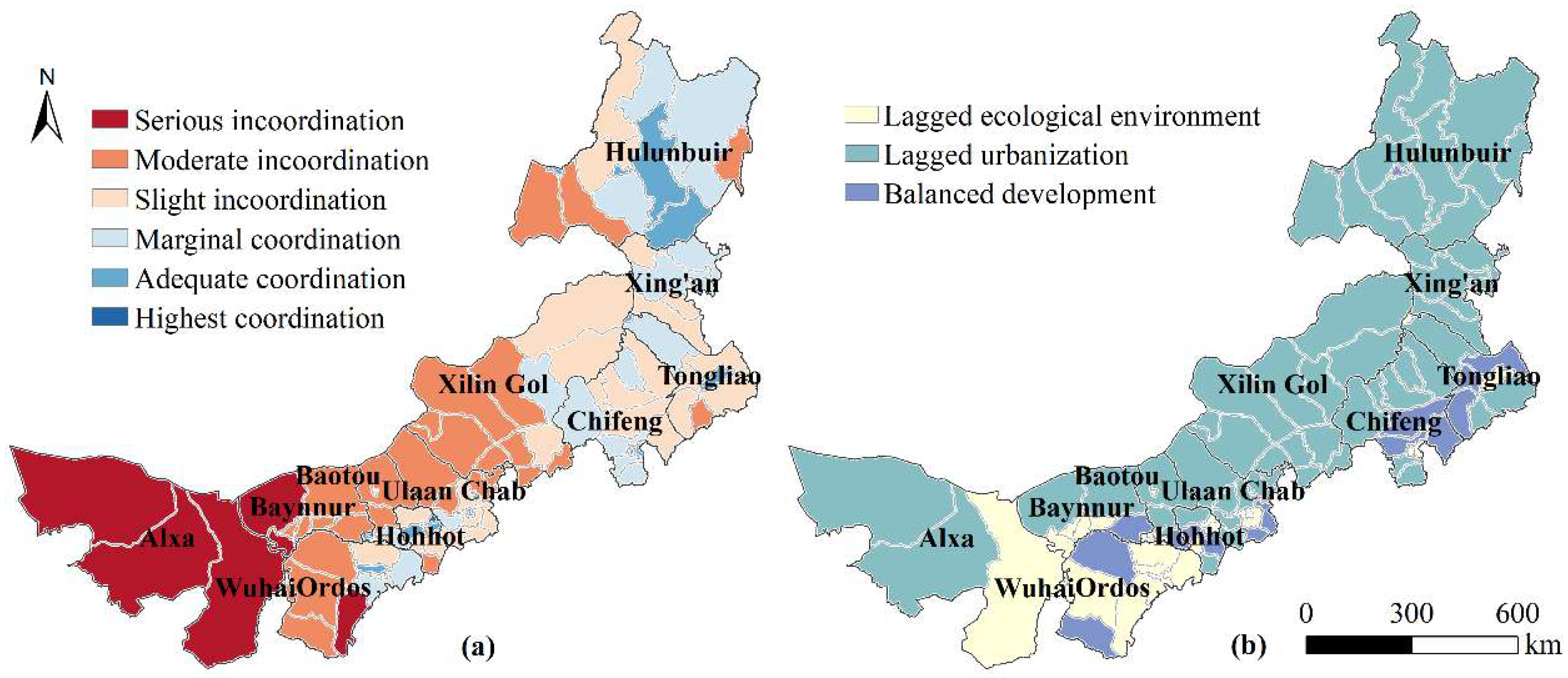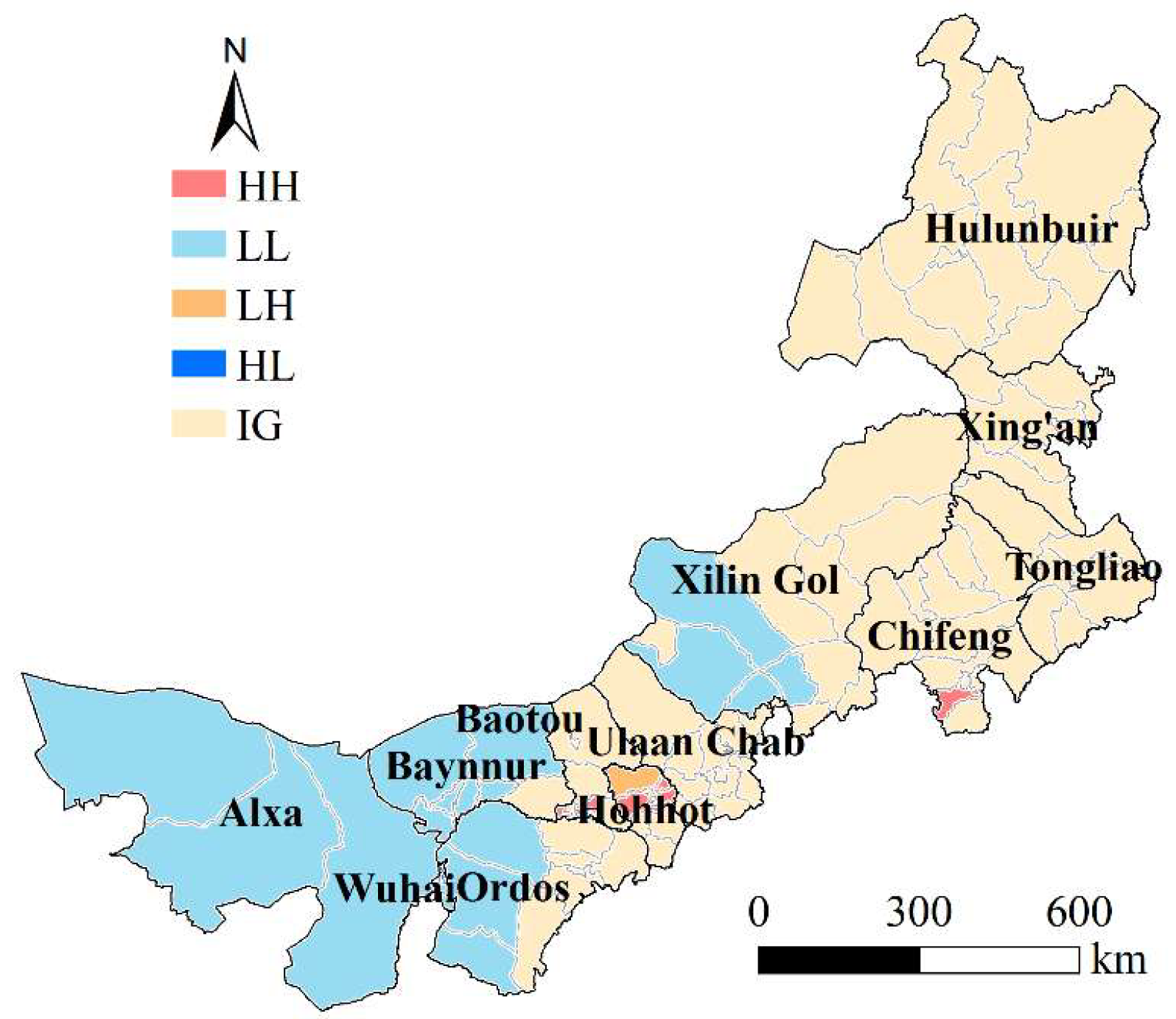A New Perspective on Functional Zoning by Integrating Coupling Coordination Analysis of Ecological Environment and Urbanization Level: A Case Study of Inner Mongolia
Abstract
1. Introduction
2. Materials and Methods
2.1. Study Area
2.2. Data Collection and Preprocessing
2.3. Methods
2.3.1. Quantification of Ecological Environment and Urbanization Level
- (1)
- Construction of Evaluation Index System
| Dimension | Indicator | Indicator Type | Justification |
|---|---|---|---|
| Pressure | Evapotranspiration | Negative | [26,28] |
| Precipitation | Positive | ||
| Temperature | Negative | ||
| PM 2.5 | Negative | ||
| Percentage of barren land area | Negative | ||
| CO2 emission | Negative | ||
| Number of livestock | Negative | ||
| State | Percentage of forest area | Positive | [28,29] |
| Percentage of grassland area | Positive | ||
| NDVI | Positive | ||
| Elevation | Negative | ||
| Response | Percentage of ecological conservation redline area | Positive | [30,31] |
| GDP percentage from the tertiary industry | Positive |
| Dimension | Indicator | Indicator Type | Justification |
|---|---|---|---|
| Population | Population | Positive | [32] |
| Economy | GDP | Positive | [8,28] |
| Nighttime light | Positive | ||
| Society | Kernel density of POI | Positive | [10,29] |
| Kernel density of check-in data | Positive | ||
| Percentage of build-up land area | Positive | ||
| Percentage of transport network area | Positive | ||
| Percentage of cropland area | Negative |
- (2)
- Weight Calculating Based on the Entropy Weight Method
2.3.2. Coupling Coordination Analysis
2.3.3. Spatial Autocorrelation Analysis
2.3.4. Clustering Analysis
3. Results
3.1. Spatial Patterns of Ecological Environment and Urbanization Level
3.2. Spatial Variations in Coupling Coordination Degree
3.3. Spatial Autocorrelation Analysis of Coupling Coordination Degree
3.4. Comprehensive Functional Zoning
4. Discussion
4.1. Implication of Spatial Relationships Between Ecological Environment and Urbanization Level
4.1.1. Uneven Developments of Subsystems
4.1.2. Spillover Effects Through Spatial Autocorrelation Analysis
4.2. Suggestions for Regional Sustainable Management
4.3. Limitations and Prospects
5. Conclusions
Author Contributions
Funding
Data Availability Statement
Conflicts of Interest
References
- Moran, M.S.; Ponce-Campos, G.E.; Huete, A.; McClaran, M.P.; Zhang, Y.; Hamerlynck, E.P.; Augustine, D.J.; Gunter, S.A.; Kitchen, S.G.; Peters, D.P.C.; et al. Functional Response of U.S. Grasslands to the Early 21st-century Drought. Ecology 2014, 95, 2121–2133. [Google Scholar] [CrossRef]
- Berdugo, M.; Delgado-Baquerizo, M.; Soliveres, S.; Hernández-Clemente, R.; Zhao, Y.; Gaitán, J.J.; Gross, N.; Saiz, H.; Maire, V.; Lehmann, A.; et al. Global Ecosystem Thresholds Driven by Aridity. Science 2020, 367, 787–790. [Google Scholar] [CrossRef]
- Liu, H.; Li, P.; Peng, C.; Liu, C.; Zhou, X.; Deng, Z.; Zhang, C.; Liu, Z. Application of Climate Change Scenarios in the Simulation of Forest Ecosystems: An Overview. Environ. Rev. 2023, 31, 565–588. [Google Scholar] [CrossRef]
- Antunes, A.C.; Berti, E.; Brose, U.; Hirt, M.R.; Karger, D.N.; O’Connor, L.M.J.; Pollock, L.J.; Thuiller, W.; Gauzens, B. Linking Biodiversity, Ecosystem Function, and Nature’s Contributions to People: A Macroecological Energy Flux Perspective. Trends Ecol. Evol. 2024, 39, 427–434. [Google Scholar] [CrossRef]
- Wen, R.; Liu, Z. Exploring Trade-Offs and Synergies between Economy Development and Ecosystem Sustainability of the Eco-Fragile Regions in the Context of Food Security. J. Clean Prod. 2025, 510, 145604. [Google Scholar] [CrossRef]
- Zhang, L.; Jia, X.; Zhao, Y.; Luo, M.; Mu, Q.; Kang, H.; Zhang, P. Long Time-Series Change Characteristics and Suitable Scale of Oasis in Arid and Semi-Arid Regions of China. Appl. Geogr. 2025, 180, 103663. [Google Scholar] [CrossRef]
- Lei, X.; Liu, H.; Li, S.; Luo, Q.; Cheng, S.; Hu, G.; Wang, X.; Bai, W. Coupling Coordination Analysis of Urbanization and Ecological Environment in Chengdu-Chongqing Urban Agglomeration. Ecol. Indic. 2024, 161, 111969. [Google Scholar] [CrossRef]
- Yang, H.; Shao, H.; Zhang, C.; Zhang, C.; Su, W.; Zhao, Q. Optimization Framework for Coupled and Coordinated Development of Ecological Environment and Urbanization in Dual-Core Urban Agglomerations: A Case Study Area of Chengdu-Chongqing. Ecol. Indic. 2025, 176, 113624. [Google Scholar] [CrossRef]
- McConnell, K.; Braneon, C.V.; Glenn, E.; Stamler, N.; Mallen, E.; Johnson, D.P.; Pandya, R.; Abramowitz, J.; Fernandez, G.; Rosenzweig, C. A Quasi-Experimental Approach for Evaluating the Heat Mitigation Effects of Green Roofs in Chicago, Illinois. Sust. Cities Soc. 2022, 76, 103376. [Google Scholar] [CrossRef]
- Liao, S.; Wu, Y.; Wong, S.W.; Shen, L. Provincial Perspective Analysis on the Coordination between Urbanization Growth and Resource Environment Carrying Capacity (RECC) in China. Sci. Total Environ. 2020, 730, 138964. [Google Scholar] [CrossRef] [PubMed]
- Yu, B. Ecological Effects of New-Type Urbanization in China. Renew. Sust. Energ. Rev. 2021, 135, 110239. [Google Scholar] [CrossRef]
- Li, S.; Liu, Y.; Elahi, E.; Meng, X.; Deng, W. A New Type of Urbanization Policy and Transition of Low-Carbon Society: A “Local- Neighborhood” Perspective. Land Use Policy 2023, 131, 106709. [Google Scholar] [CrossRef]
- Qi, X.; Chen, J.; Wang, J.; Liu, H.; Ding, B. The Impact of Urbanization on the Alleviation of Energy Poverty: Evidence from China. Cities 2024, 151, 105130. [Google Scholar] [CrossRef]
- Wu, H.; Gui, Z.; Yang, Z. Geospatial Big Data for Urban Planning and Urban Management. Geo-Spat. Inf. Sci. 2020, 23, 273–274. [Google Scholar] [CrossRef]
- Wang, S.; Li, Z.; Long, Y.; Yang, L.; Ding, X.; Sun, X.; Chen, T. Impacts of Urbanization on the Spatiotemporal Evolution of Ecological Resilience in the Plateau Lake Area in Central Yunnan, China. Ecol. Indic. 2024, 160, 111836. [Google Scholar] [CrossRef]
- Dakos, V.; Kéfi, S. Ecological Resilience: What to Measure and How. Environ. Res. Lett. 2022, 17, 043003. [Google Scholar] [CrossRef]
- Feng, Y.; Feng, J.; Li, C. Progress of the Spatiotemporal Change and Improvement of Green Space from the Perspective of Ecological Resilience. Acta Ecol. Sin. 2023, 43, 5648–5661. [Google Scholar]
- Tang, F.; Wang, L.; Guo, Y.; Fu, M.; Huang, N.; Duan, W.; Luo, M.; Zhang, J.; Li, W.; Song, W. Spatio-Temporal Variation and Coupling Coordination Relationship between Urbanisation and Habitat Quality in the Grand Canal, China. Land Use Pol. 2022, 117, 106119. [Google Scholar] [CrossRef]
- Li, W.; Wang, Y.; Xie, S.; Cheng, X. Coupling Coordination Analysis and Spatiotemporal Heterogeneity between Urbanization and Ecosystem Health in Chongqing Municipality, China. Sci. Total Environ. 2021, 791, 148311. [Google Scholar] [CrossRef]
- Tu, D.; Cai, Y.; Liu, M. Coupling Coordination Analysis and Spatiotemporal Heterogeneity between Ecosystem Services and New-Type Urbanization: A Case Study of the Yangtze River Economic Belt in China. Ecol. Indic. 2023, 154, 110535. [Google Scholar] [CrossRef]
- Jiang, H.; Peng, J.; Zhao, Y.; Xu, D.; Dong, J. Zoning for Ecosystem Restoration Based on Ecological Network in Mountainous Region. Ecol. Indic. 2022, 142, 109138. [Google Scholar] [CrossRef]
- Li, J.; Hu, D.; Wang, Y.; Chu, J.; Yin, H.; Ma, M. Study of Identification and Simulation of Ecological Zoning through Integration of Landscape Ecological Risk and Ecosystem Service Value. Sust. Cities Soc. 2024, 107, 105442. [Google Scholar] [CrossRef]
- Li, C.; Fu, B.; Wang, S.; Stringer, L.C.; Wang, Y.; Li, Z.; Liu, Y.; Zhou, W. Drivers and Impacts of Changes in China’s Drylands. Nat. Rev. Earth Environ. 2021, 2, 858–873. [Google Scholar] [CrossRef]
- Li, T.; Jia, Y.; Fava, F.; Xu, Z.; Zhu, J.; Yang, Y.; Tang, L.; Wang, Y.; Hao, Y.; Cui, X. A Geographic Identification of Sustainable Development Obstacles and Countermeasures in Drylands: A Case Study in Inner Mongolia, China. Ecol. Indic. 2021, 132, 108257. [Google Scholar] [CrossRef]
- Wolfslehner, B.; Vacik, H. Evaluating Sustainable Forest Management Strategies with the Analytic Network Process in a Pressure-State-Response Framework. J. Environ. Manag. 2008, 88, 1–10. [Google Scholar] [CrossRef] [PubMed]
- Han, C.; Zheng, J.; Guan, J.; Yu, D.; Lu, B. Evaluating and Simulating Resource and Environmental Carrying Capacity in Arid and Semiarid Regions: A Case Study of Xinjiang, China. J. Clean. Prod. 2022, 338, 130646. [Google Scholar] [CrossRef]
- Lv, X.; Xiao, W.; Zhao, Y.; Zhang, W.; Li, S.; Sun, H. Drivers of Spatio-Temporal Ecological Vulnerability in an Arid, Coal Mining Region in Western China. Ecol. Indic. 2019, 106, 105475. [Google Scholar] [CrossRef]
- Jiang, Y.; Shi, B.; Su, G.; Lu, Y.; Li, Q.; Meng, J.; Ding, Y.; Song, S.; Dai, L. Spatiotemporal Analysis of Ecological Vulnerability in the Tibet Autonomous Region Based on a Pressure-State-Response-Management Framework. Ecol. Indic. 2021, 130, 108054. [Google Scholar] [CrossRef]
- Zhang, M.; Bao, Y.; Xu, J.; Han, A.; Liu, X.; Zhang, J.; Tong, Z. Ecological Security Evaluation and Ecological Regulation Approach of East-Liao River Basin Based on Ecological Function Area. Ecol. Indic. 2021, 132, 108255. [Google Scholar] [CrossRef]
- Chen, X.; Yu, L.; Lin, W.; Yang, F.; Li, Y.; Tao, J.; Cheng, S. Urban Resilience Assessment from the Multidimensional Perspective Using Dynamic Bayesian Network: A Case Study of Fujian Province, China. Reliab. Eng. Syst. Saf. 2023, 238, 109469. [Google Scholar] [CrossRef]
- Liu, J.; Xu, X.; Zou, C.; Lin, N.; Zhang, K.; Shan, N.; Zhang, H.; Liu, R. A Bayesian Network-GIS Probabilistic Model for Addressing Human Disturbance Risk to Ecological Conservation Redline Areas. J. Environ. Manag. 2023, 344, 118400. [Google Scholar] [CrossRef]
- Wang, R.; Xiao, Y.; Huang, H.; Chang, M. Exploring the Complex Relationship between Industrial Upgrading and Energy Eco-Efficiency in River Basin Cities: A Case Study of the Yellow River Basin in China. Energy 2024, 312, 133498. [Google Scholar] [CrossRef]
- Liang, L.; Zhang, F.; Wu, F.; Chen, Y.; Qin, K. Coupling Coordination Degree Spatial Analysis and Driving Factor between Socio-Economic and Eco-Environment in Northern China. Ecol. Indic. 2022, 135, 108555. [Google Scholar]
- Xing, L.; Xue, M.; Hu, M. Dynamic Simulation and Assessment of the Coupling Coordination Degree of the Economy–Resource–Environment System: Case of Wuhan City in China. J. Environ. Manag. 2019, 230, 474–487. [Google Scholar] [CrossRef] [PubMed]
- Wei, W.; Yuan, Z.; Wei, X.; Dou, H.; Xiong, J. Coupling Coordination Relationship Between Gross Ecosystem Product and Economic Development in Important Ecological Functional Areas: A Case Study in the Yellow River Basin. Econ. Geogr. 2024, 44, 161–172. [Google Scholar]
- Li, X.; Meng, X.; Ji, X.; Zhou, J.; Pan, C.; Gao, N. Zoning Technology for the Management of Ecological and Clean Small-Watersheds via k-Means Clustering and Entropy-Weighted TOPSIS: A Case Study in Beijing. J. Clean Prod. 2023, 397, 136449. [Google Scholar] [CrossRef]
- Ma, R.; Huang, Y.; Zhou, W.; Ren, J.; Wang, H.; Shi, Z.; Wang, J. How to Transform Cultivated Land Protection on the Northeast Tibetan Plateau? A Multifunctional Path Exploration. Ecol. Indic. 2025, 170, 112988. [Google Scholar] [CrossRef]
- Zhou, Y.; Wu, T.; Wang, Y. Urban Expansion Simulation and Development-Oriented Zoning of Rapidly Urbanising Areas: A Case Study of Hangzhou. Sci. Total Environ. 2022, 807, 150813. [Google Scholar] [CrossRef]
- Liao, Z.; Su, K.; Jiang, X.; Wang, J.; You, Y.; Wang, L.; Chang, S.; Wei, C.; Zhang, Y.; Li, C. Spatiotemporal Variation and Coupling of Grazing Intensity and Ecosystem Based on Four Quadrant Model on the Inner Mongolia. Ecol. Indic. 2023, 152, 110379. [Google Scholar] [CrossRef]
- Tian, Z.; Yu, Y.; Huang, C. Spatial Distribution Characteristics and Influencing Factors of Tourism Elements in Inner Mongolia Counties Based on POI Data. Arid Land Geogr. 2025, 48, 1255–1266. [Google Scholar]
- Cheng, X.; Long, R.; Chen, H.; Li, Q. Coupling Coordination Degree and Spatial Dynamic Evolution of a Regional Green Competitiveness System - A Case Study from China. Ecol. Indic. 2019, 104, 489–500. [Google Scholar] [CrossRef]
- Luo, L.; Wang, Y.; Liu, Y.; Zhang, X.; Fang, X. Where Is the Pathway to Sustainable Urban Development? Coupling Coordination Evaluation and Configuration Analysis between Low-Carbon Development and Eco-Environment: A Case Study of the Yellow River Basin, China. Ecol. Indic. 2022, 144, 109473. [Google Scholar] [CrossRef]
- Bi, X.; Shen, L.; Feng, G.; Zhou, P. The Interaction Mechanisms between Urbanization and Ecosystems from a Telecoupling Perspective: A Case Study of the Yangtze River Delta Region [J/OL]. Chin. J. Ecol. 2025, 1–17. [Google Scholar]
- Xiao, R.; Yu, X.; Xiang, T.; Zhang, Z.; Wang, X.; Wu, J. Exploring the Coordination between Physical Space Expansion and Social Space Growth of China’s Urban Agglomerations Based on Hierarchical Analysis. Land Use Pol. 2021, 109, 105700. [Google Scholar] [CrossRef]
- Thogersen, J. Spillover Processes in the Development of a Sustainable Consumption Pattern. J. Econ. Psychol. 1999, 20, 53–81. [Google Scholar] [CrossRef]
- Zhang, Y.; Liu, Y.; Zhang, Y.; Liu, Y.; Zhang, G.; Chen, Y. On the Spatial Relationship between Ecosystem Services and Urbanization: A Case Study in Wuhan, China. Sci. Total Environ. 2018, 637–638, 780–790. [Google Scholar] [CrossRef]
- Yang, H.; Gou, X.; Xue, B.; Xu, J.; Wei, Y.; Ma, W. Measuring the Cross-Border Spillover Effects and Telecoupling Processes of Ecosystem Services in Western China. Environ. Res. 2023, 239, 117291. [Google Scholar] [CrossRef]
- Stern, R.; Muller, J.D.; Rotenberg, E.; Amer, M.; Segev, L.; Yakir, D. Photovoltaic Fields Largely Outperform Afforestation Efficiency in Global Climate Change Mitigation Strategies. PNAS Nexus 2023, 2, pgad352. [Google Scholar] [CrossRef]
- Wu, X.; Zhang, J.; Geng, X.; Wang, T.; Wang, K.; Liu, S. Increasing Green Infrastructure-Based Ecological Resilience in Urban Systems: A Perspective from Locating Ecological and Disturbance Sources in a Resource-Based City. Sustain. Cities Soc. 2020, 61, 102354. [Google Scholar] [CrossRef]
- Li, L.; Wang, N.; Hao, Z.; Sun, B.; Gao, B.; Gou, M.; Wang, P.; Pei, N. Urbanization Intensifies the Imbalance between Human Development and Biodiversity Conservation: Insights from the Coupling Analysis of Human Activities and Habitat Quality. Land Degrad. Dev. 2024, 35, 3606–3626. [Google Scholar] [CrossRef]






| Type | Data | Resolution | Sources |
|---|---|---|---|
| Land use data | Land use data | 1 km | Resources and Environment Data Center of the Chinese Academy of Sciences (https://www.resdc.cn/ (accessed on 25 May 2025)) |
| Meteorology data | Precipitation | 1 km | National Tibetan Plateau Data Center (https://data.tpdc.ac.cn/ (accessed on 25 May 2025)) |
| Temperature | |||
| Evapotranspiration | |||
| Topography data | DEM | 90 m | Geospatial Data Cloud (https://www.gscloud.cn/ (accessed on 25 May 2025)) |
| NDVI | NDVI | 500 m | National Aeronautics and Space Administration (NASA) (https://www.earthdata.nasa.gov/ (accessed on 25 May 2025)) |
| POI data | POI data | txt | Amap (https://www.amap.com/ (accessed on 25 May 2025)) |
| Social media data | Check-in data | txt | Sina Weibo (https://weibo.com/ (accessed on 25 May 2025)) |
| PM 2.5 | PM 2.5 | 1 km | National Earth System Science Data Center (https://geodata.nnu.edu.cn/ (accessed on 25 May 2025)) |
| Nighttime light data | Nighttime light data | 1 km | National Earth System Science Data Center (https://geodata.nnu.edu.cn/ (accessed on 25 May 2025)) |
| CO2 emission data | CO2 emission data | 0.1° | Emissions Database for Global Atmospheric Research (https://edgar.jrc.ec.europa.eu/emissions_data_and_maps (accessed on 25 May 2025)) |
| Transport network | Railways | shp | OpenStreetMap (https://www.openstreetmap.org) |
| Highways | |||
| Ecological conservation redline dataset | Ecological conservation redline dataset | shp | Territorial Spatial Planning of Inner Mongolia Autonomous Region (https://zrzy.nmg.gov.cn/zfxxgkzl/fdzdgknr/ghjh/gh/202407/t20240723_2545743.html (accessed on 25 May 2025)) |
| Socio-economic data | Population | xls | Statistical yearbook of Inner Mongolia |
| GDP |
| CCD Value | Degree | Ratio | Characteristic |
|---|---|---|---|
| ≤ 0.225 | Serious incoordination | 0 < ≤ 2 | Lagged ecological environment |
| 2 < ≤ 4 | Balanced development | ||
| 4 < | Lagged urbanization | ||
| 0.226 < ≤ 0.292 | Moderate incoordination | 0 < ≤ 2 | Lagged ecological environment |
| 2 < ≤ 4 | Balanced development | ||
| 4 < | Lagged urbanization | ||
| 0.293 < ≤ 0.337 | Slight incoordination | 0 < ≤ 2 | Lagged ecological environment |
| 2 < ≤ 4 | Balanced development | ||
| 4 < | Lagged urbanization | ||
| 0.338 < ≤ 0.393 | Marginal coordination | 0 < ≤ 2 | Lagged ecological environment |
| 2 < ≤ 4 | Balanced development | ||
| 4 < | Lagged urbanization | ||
| 0.394 < ≤ 0.515 | Adequate coordination | 0 < ≤ 2 | Lagged ecological environment |
| 2 < ≤ 4 | Balanced development | ||
| 4 < | Lagged urbanization | ||
| 0.516 < | Highest coordination | 0 < ≤ 2 | Lagged ecological environment |
| 2 < ≤ 4 | Balanced development | ||
| 4< | Lagged urbanization |
Disclaimer/Publisher’s Note: The statements, opinions and data contained in all publications are solely those of the individual author(s) and contributor(s) and not of MDPI and/or the editor(s). MDPI and/or the editor(s) disclaim responsibility for any injury to people or property resulting from any ideas, methods, instructions or products referred to in the content. |
© 2025 by the authors. Licensee MDPI, Basel, Switzerland. This article is an open access article distributed under the terms and conditions of the Creative Commons Attribution (CC BY) license (https://creativecommons.org/licenses/by/4.0/).
Share and Cite
Liu, Y.; Liu, Z.; Chi, W.; Jin, B.; Zhang, X.; Wang, Y. A New Perspective on Functional Zoning by Integrating Coupling Coordination Analysis of Ecological Environment and Urbanization Level: A Case Study of Inner Mongolia. Land 2025, 14, 1692. https://doi.org/10.3390/land14081692
Liu Y, Liu Z, Chi W, Jin B, Zhang X, Wang Y. A New Perspective on Functional Zoning by Integrating Coupling Coordination Analysis of Ecological Environment and Urbanization Level: A Case Study of Inner Mongolia. Land. 2025; 14(8):1692. https://doi.org/10.3390/land14081692
Chicago/Turabian StyleLiu, Yu, Zhengjia Liu, Wenfeng Chi, Bowen Jin, Xun Zhang, and Yu Wang. 2025. "A New Perspective on Functional Zoning by Integrating Coupling Coordination Analysis of Ecological Environment and Urbanization Level: A Case Study of Inner Mongolia" Land 14, no. 8: 1692. https://doi.org/10.3390/land14081692
APA StyleLiu, Y., Liu, Z., Chi, W., Jin, B., Zhang, X., & Wang, Y. (2025). A New Perspective on Functional Zoning by Integrating Coupling Coordination Analysis of Ecological Environment and Urbanization Level: A Case Study of Inner Mongolia. Land, 14(8), 1692. https://doi.org/10.3390/land14081692








